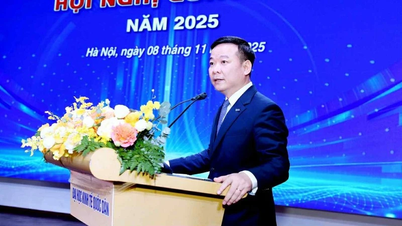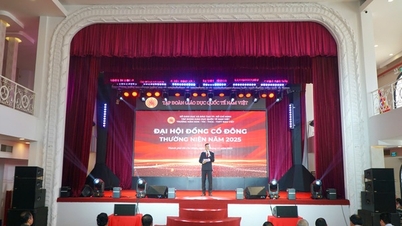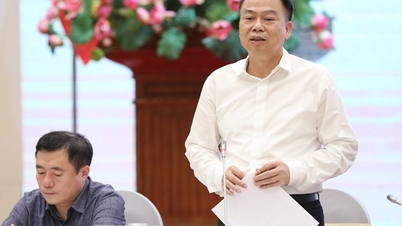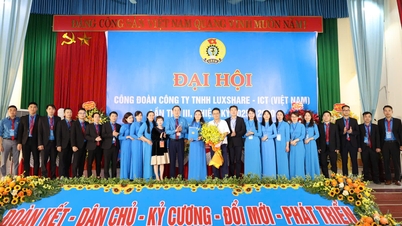At the opening ceremony on October 30, MSc. Luong The Phuc, Vice Principal in charge of Ho Chi Minh City Agricultural Technical College, said that for the first time, the opening ceremony of the school year was held at the hall of the Management Board of Ho Chi Minh City High-Tech Agricultural Park (AHTP).
Expectations to rise when "changing owners"
MSc. Luong The Phuc said that while waiting for the competent authority's document on organization and arrangement of the apparatus, the Department of Agriculture and Environment of Ho Chi Minh City has ceased its role as the managing authority, the official handover to AHTP has not been completed yet but the school is still trying to fully train 5 classes, equivalent to 151 students. The newly opened course increased from 34 to 41 students admitted to 2 majors: veterinary animal husbandry and crop cultivation - plant protection, a rather modest number. However, these are the first students to be trained in the new "transfer" phase with modern facilities, training programs and laboratory systems.

Ho Chi Minh City Agricultural Technical College just held the opening ceremony even though there were only 41 students in the new course.
Mr. Nguyen Thanh Hien, Deputy Head of AHTP Management Board, said that when receiving the Ho Chi Minh City Agricultural Technical College, the school was in a very difficult period. However, the management board leaders considered this a long-term strategic move.
Before the merger, the agricultural land ratio of Ho Chi Minh City was not high (mainly concentrated in Cu Chi, Hoc Mon, Binh Chanh, Can Gio districts). After the merger, with the acquisition of additional agricultural land and non-urbanized land from Binh Duong and Ba Ria - Vung Tau areas, the agricultural land ratio in the total area structure of Ho Chi Minh City is just over 60%. "The potential for agricultural land is very large, which leads to a very high demand for highly skilled human resources in this field. If utilized and developed well, the school will be an extension of AHTP, carrying out the task of training human resources, researching, applying and spreading technology for Ho Chi Minh City" - Mr. Hien affirmed.
One of the school's top priorities at the present stage is to implement innovation and rectify the school's recruitment and communication work. AHTP has directed the urgent renovation of the school campus; restored and upgraded the school's website and fanpage, and established a mechanism to link data directly to the official AHTP information page. The goal is to complete it in November, to meet the enrollment schedule for training programs in 2026.
In addition, AHTP has also directed the school to develop a training plan for the period 2026-2030 to meet the human resource needs of high-tech agricultural areas. In addition, AHTP leaders are promoting the application for investment projects to renovate, repair and renovate the entire school's facilities.
"All staff and teachers of the school are very happy to receive this information. It can be said that the merger and change of management agency is helping the school "revive". The most specific existing benefit is that students can comfortably use the laboratories and modern equipment of AHTP to apply to their studies" - Master Phuc happily said.
Meanwhile, facing the burden of persistent salary arrears, the Board of Directors of Binh Thanh Vocational College expressed joy and great expectations for the upcoming merger, considering it the only way out to restructure the unit. The school leaders believe that the merger will bring about fundamental changes, solving the root causes of the current difficulties.
On the other hand, the merger will help the school raise its status, move from intermediate to college, expand the target and recruitment area. This is considered a liberation, creating new development space, escaping the intermediate system which has been degraded in many aspects.
The school's leaders believe that if they strengthen training models according to orders from industrial parks and associations, ensuring a stable source of income from standardizing skills for thousands of workers each year, the school will have funds to pay salaries, help staff feel secure and develop new jobs.
A big turning point for vocational schools
Mr. Lam Van Quan, Chairman of the Ho Chi Minh City Vocational Education Association, said that Resolution 71 on the arrangement and merger of educational institutions is not only an administrative decision, but also a major turning point in the educational reform process. This is a strong affirmation of the national vision in developing high-quality human resources, especially in the context of the fourth industrial revolution and digital transformation taking place strongly.
If Resolution 29 was previously considered an "outline for innovation", Resolution 71 is an "institutional revolution" aimed at innovating governance, strengthening autonomy and improving accountability of educational institutions.
Experts say the biggest difficulty lies not in the story of model mergers but in the change in management thinking and adaptability of vocational training institutions.
In terms of administration, many vocational schools are still familiar with administrative management mechanisms and are not really ready to move to an autonomous model, which requires strategic planning capacity, effective pressure and high accountability.
In terms of the market, the clear difference in adaptability has created a contrasting situation. Some schools have made breakthroughs and increased enrollment, but others have "lost ground" and had to "shelve".
Psychologically, mergers will lead to fear of "losing the school name, losing identity". We need to change our perspective: mergers are not about losing, but about upgrading to develop stronger - creating a combined strength, where the core professional values of each school are multiplied.
"For vocational education, Resolution 71 creates a clear legal corridor for vocational schools to truly become pillars in the national education system. The main goal is for vocational education to transform substantially, from "training to work" to "training to work and innovate, create, and lead", to meet the needs of the domestic and international labor market" - Associate Professor - Master Lam Van Quan said.
Resolution 71 has repositioned vocational education in the national education ecosystem: Not just "vocational training" in the narrow sense, but a comprehensive human development system, where learners are equipped with vocational capacity, digital skills, and creative qualities to adapt to rapid changes in technology.
To improve the quality of human resources and strengthen the position of vocational education, Master Tran Thanh Hai, Principal of Far East College (HCMC), proposed that the first thing to do is to apply mandatory practice certificates for fields such as construction, accounting, and network security, along with continuing education certificates to enhance community responsibility, as a basis for business ranking and salary payment.
Second, the state should switch to a bidding mechanism to encourage all training institutions (public and private) to participate in providing services, promoting the socialization of vocational training. Third, there should be a roadmap to increase subsidies for students after junior high school/high school studying specialized, hard-to-recruit majors such as: mechanics, automation, cyber security, nursing... Fourth, to ensure quality, it is necessary to separate the pathway to university from college, instead of including the entire intermediate level as at present.
Finally, it is necessary to facilitate international cooperation between Vietnamese vocational schools and FDI enterprises, helping training meet global market needs.
(*) See Lao Dong Newspaper from November 7 issue
245 colleges join the common admission system
According to the Department of Vocational Education and Continuing Education, as of September 2025, the country has 1,163 vocational training institutions, of which more than 55% are non-public. Enrollment will reach 2.43 million people in 2024, with nearly 1 million people in the first 6 months of 2025 alone. 245 colleges have joined the joint enrollment system with universities, expanding learning opportunities.
Source: https://nld.com.vn/truong-nghe-hoang-tan-no-luong-trien-mien-cu-hich-de-hoi-sinh-but-pha-196251107212327356.htm







![[Photo] Cutting hills to make way for people to travel on route 14E that suffered landslides](https://vphoto.vietnam.vn/thumb/1200x675/vietnam/resource/IMAGE/2025/11/08/1762599969318_ndo_br_thiet-ke-chua-co-ten-2025-11-08t154639923-png.webp)



















![[Photo] "Ship graveyard" on Xuan Dai Bay](https://vphoto.vietnam.vn/thumb/1200x675/vietnam/resource/IMAGE/2025/11/08/1762577162805_ndo_br_tb5-jpg.webp)








![[Video] Hue Monuments reopen to welcome visitors](https://vphoto.vietnam.vn/thumb/402x226/vietnam/resource/IMAGE/2025/11/05/1762301089171_dung01-05-43-09still013-jpg.webp)







































































Comment (0)